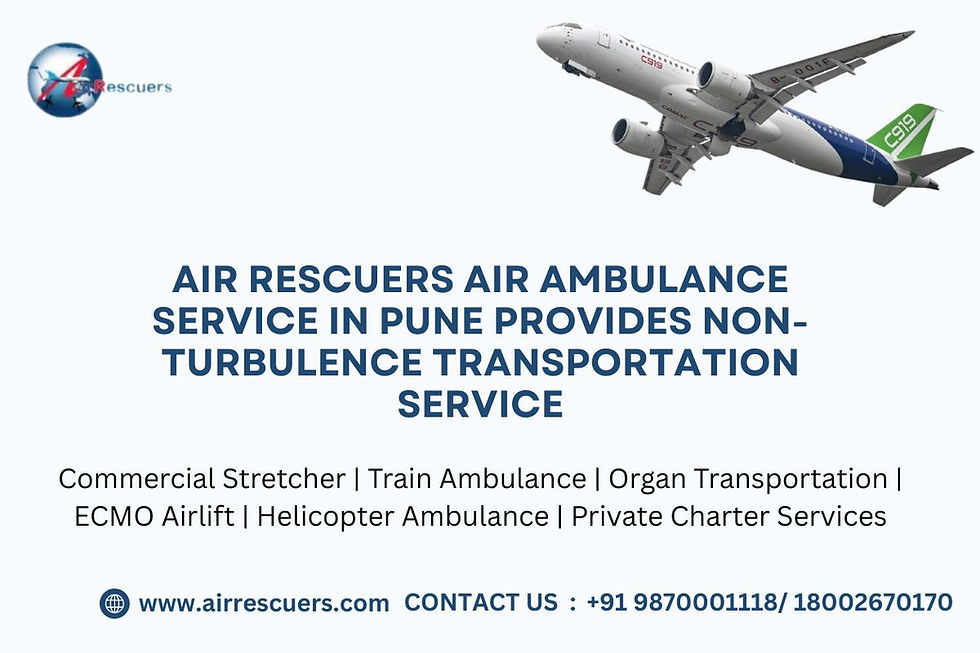How Can Air Ambulances Save Lives in Critical Situations?
- archi20255
- Apr 3
- 4 min read

Introduction
In medical emergencies, time is often the deciding factor between life and death. Air ambulances play an important role in ensuring rapid medical transport, especially in cases where ground ambulances are not fast or efficient enough. Whether it is a serious accident, organ transplant, stroke, heart attack, or other life-threatening situations, air ambulances provide quick, well-equipped, and professional medical assistance to save lives. In this article, we will explore how air ambulances work, their importance in critical situations and what major benefits they provide for emergency medical care.
What Is an Air Ambulance?
An air ambulance is a specially equipped aircraft — either a helicopter or a fixed-wing airplane — designed for emergency medical transport. These aircraft carry trained paramedics, doctors and nurses and are equipped with ICU-grade medical equipment to provide critical care support to critically ill or injured patients.
Types of Air Ambulances
Helicopter Air Ambulances
Used for short-distance emergency transport.
Ideal for transporting patients from remote areas, accident sites, or places with limited road access.
Can land directly at hospitals or emergency sites.
Fixed-Wing Air Ambulances
Used for long-distance patient transport (intercity or international).
Provide pressurized cabins, advanced life support (ALS), and medical teams.
Suitable for organ transplants, critical patient transfers, and disaster evacuations.
How Air Ambulances Save Lives in Critical Situations
1. Rapid Response to Medical Emergencies
The biggest advantage of air ambulances is their speed. In life-threatening situations like heart attack, stroke, severe burns or multi-organ failure, reaching a specialized hospital quickly can be the difference between survival and death.
For example, if a patient suffers a severe stroke in a remote village, it may take hours for a ground ambulance to reach a specialized stroke centre. An air ambulance can cover the same distance in minutes, ensuring the patient receives critical care without delay.
2. Safe Patient Transport from Remote or Disaster-Stricken Areas
Air ambulances are life-saving in cases where conventional ambulances cannot operate efficiently due to the following reasons:
Floods, earthquakes or other natural calamities.
Accidents in mountainous, wooded or rural areas where road access is poor.
Severe traffic congestion impedes prompt road transport.
During disasters, air ambulances transport injured survivors to hospitals, ensuring they get immediate medical care.
3. ICU-Level In-Flight Medical Support
Ventilator for respiratory failure patients.
cardiac monitor and defibrillator for heart attack patients.
Infusion pumps for continuous drug administration.
Oxygen supply and critical care support
This makes air ambulances the safest and most advanced option for transporting critical patients who need continuous medical supervision.
4. Organ Transport and Transplant Support
Organ transplantation is a race against time. Organs like hearts, lungs, and livers must be transplanted within a few hours of retrieval. Air ambulances are crucial in:
Transporting organs quickly from one city to another.
Ensuring donor organs reach the recipient hospital in time.
Moving transplant patients to specialized hospitals for surgery.
For instance, if a donor heart becomes available in Delhi, but the recipient is in Raipur, an air ambulance can transport the organ within a couple of hours, significantly increasing the success rate of the transplant.
5. International Medical Evacuations
Many critical patients require treatment in specialized hospitals abroad. Air ambulances facilitate:
Safe international patient transfer with medical teams on board.
Coordination with immigration and hospital authorities for smooth evacuation.
Transport for tourists or expats facing medical emergencies in foreign countries.
For example, if a traveler in Raipur suffers a severe heart attack and needs specialized treatment in India, an Air Ambulance Services in Raipur can bring them home safely.
Key Benefits of Air Ambulances
Faster Than Road Transport
Air ambulances bypass traffic and cover long distances in minutes instead of hours.
Advanced Life-Saving Equipment
Onboard ICU facilities, ventilators, cardiac monitors, and emergency medications ensure critical care in transit.
Highly Trained Medical Teams
Specialist doctors, paramedics, and nurses provide continuous care during transport.
Nationwide and International Reach
Can evacuate patients from any location—rural, urban, or international.
Ideal for High-Risk Patients
Suitable for newborns, elderly patients, organ transplant cases, and trauma victims requiring intensive care.
Choosing the Right Air Ambulance Service
When selecting an air ambulance provider, consider:
Response time – Faster deployment can save lives.
Medical equipment – Ensure they have ICU-level care.
Experienced staff – Certified doctors and paramedics.
Global reach – If international transport is needed.
Affordability & Insurance – Check cost and insurance coverage.
One such reliable service provider is Air Rescuers, offering fast, safe, and efficient air ambulance services in Raipur, Pune, Patna and all over India.
Conclusion
Air ambulances are indispensable in critical medical situations, offering fast, efficient, and life-saving transport for patients who need urgent care. Whether it’s severe trauma, organ transport, accident injuries, or medical evacuations, air ambulances ensure patients reach the best medical facilities without delay.
With their ICU-grade equipment, trained medical teams, and rapid response, air ambulances continue to save countless lives every year. Choosing a trusted service provider can make all the difference when time is running out.












Comments